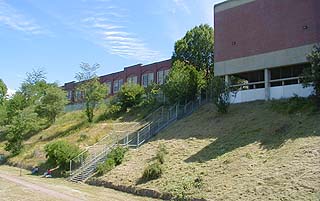|
Subscribe / Renew |
|
|
Contact Us |
|
| ► Subscribe to our Free Weekly Newsletter | |
| home | Welcome, sign in or click here to subscribe. | login |
Construction
| |
 |
August 21, 2003
Value engineering pays off for Seattle Schools
Coughlin Porter Lundeen

Photo courtesy of CPL
An expensive plan to export excavation materials from a school renovation project in Seattle was scuttled in favor using the materials to elevate the school’s athletic field. The plan will save $250,000 and shorten the distance between the school and the field, which sits 54 feet below.
|
Had the traditional design-bid-build approach been followed, Madison Middle School’s $38.4 million historic renovation project may have taken much longer to plan and build.
Like all large historic renovations, the Madison project is complex because the Seattle School District structure will receive significant life-safety and seismic upgrades. Site work began in July, and completion is slated for fall of 2005.
Mixing old and new
Strict budget and schedule constraints posed immediate concerns for engineers planning the project, as did the need to safely mix historic elements with a new state-of-the-art facility.
The original structure, designed by NBBJ co-founder Floyd Naramore, was constructed in 1929 and is listed as a Seattle Historic Landmark. Additions were built in 1931, and a stand-alone gym was added in 1971.
Coughlin Porter Lundeen is the civil and structural engineer on the Bassetti Architects-led design team responsible for renovating the 130,000-square-foot school.
The school includes one-, two- and three-story structures situated on a sloping, 8-acre site. The one- and two-story portions of the school, which were constructed in later additions, will be demolished and replaced. The original three-story structure, which includes the main lobby and the classroom and administration wing, will remain.
Late-fall excavation
Performing a comprehensive renovation within the district’s required schedule poses a considerable challenge.
Engineers have responded by developing a two-phased approach to the project, starting with a comprehensive study of the site and its structures.
The resulting Phase I plan includes improvements to the masonry structure, particularly where it relates to the school’s foundation. Work was originally scheduled to finish in late fall. In this case, design plans called for significant over-excavation at the foundation of the original building.
The excavation would be open to the elements throughout construction despite the fall start of the project’s second phase, raising concerns about wet weather and the stability of the site. An exposed site in Seattle’s rainy climate can mean significant problems with site access and potential claims.
Instead, engineers settled on using soilcrete to provide a concretelike surface throughout the excavated areas. The impervious surface provides excellent working conditions, not to mention a site ready to pass off to Phase II contractors.
Elevating the field
An initial plan to export all of the excavation materials from the site was expected to be costly. The issue was one of many addressed during the early value-engineering phase of the project.
The design team instead developed a plan to reuse most of the excavation materials at nonstructural locations, such as on the school’s sports field, where the elevation will rise 12 feet — and $250,000 will be saved in the process. Raising the field also helps close its 54-foot grade difference with the gym, which is connected by a long stairway.
Geothermal energy
The new facility will incorporate a geothermal heat pump to improve the building’s environmental sustainability.
Operation costs for the facility will be less expensive over the life of the project, making the geothermal system cost-effective. Coughlin Porter Lundeen is coordinating the civil issues related to the integration of this technology via the location of 176 320-foot-deep wells and associated piping.
Research pays off
Issues related to stormwater requirements were of great concern since the site had no room for a stormwater detention pond.
Typically, a very large and costly underground vault would have to have been built. But engineers, after researching the issue, determined the project was exempted from stormwater detention requirements because the site discharged directly into Puget Sound. That research saved $1 million.
Gayle Guadarrama is marketing director at Seattle-based Coughlin Porter Lundeen.
Other Stories:
- America’s ongoing school-building crunch
- Tomorrow’s schools could be neighborhood hubs
- New standards will help schools go green
- Keeping up with the Joneses
- Insurers slash coverage for contractors
- High school embraces small-school format
- Better buildings can boost savings down the road


